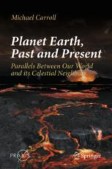Search
Search Results
-
Perseverance’s Scanning Habitable Environments with Raman and Luminescence for Organics and Chemicals (SHERLOC) Investigation
The Scanning Habitable Environments with Raman and Luminescence for Organics and Chemicals (SHERLOC) is a robotic arm-mounted instrument on NASA’s Perseverance...

-
Predicted diversity in water content of terrestrial exoplanets orbiting M dwarfs
Exoplanet surveys around M dwarfs have detected a growing number of exoplanets with Earth-like insolation. It is expected that some of those planets...

-
Taxonomy of Extrasolar Systems for the Main Sequence Stars
AbstractIn this paper we present the guidelines for an extrasolar system taxonomy. When working with an extra-solar planet database, it is very...

-
Earth=Asteroid belt: the impact of uneasy relationships during the great solar system cleanup
Planetary origin theories; the early solar nebula; carbonaceous chondrites; accretion and feeding zones; differentiation and...
-
Activity of the Star Gl 414A with Two Planets and its Effect on the Loss of Mass of the Atmosphere of the Planet Gl 414A b
Results are presented from a study of manifestations of the activity of the dwarf Gl 414A of spectral class K7 with two planets, one of which (the...
-
Atmospheric carbon depletion as a tracer of water oceans and biomass on temperate terrestrial exoplanets
The conventional observables to identify a habitable or inhabited environment in exoplanets, such as an ocean glint or abundant atmospheric O 2 , will...

-
Distant Earths: exoplanets with potential
Early observations and the plurality of worlds; the Earth’s habitable factors and the Earth Similarity Index; gamma ray bursts; the...
-
Activity of TRAPPIST-1 Analogs
AbstractThe planetary system of the star TRAPPIST-1 hosts seven exoplanets, three of which are in the habitable zone. Based on published data, we...

-

-
Finding Stellar Flares with Recurrent Deep Neural Networks
At present, low-mass, cool M dwarfs are the prime targets of planet searches, since the habitable zone is much closer to the central object in cool...
-
Earth=Venus, part II: future Earth?
A review of the Earth’s history; ancient climate records; continents and climate, little ice ages; migrating habitable zones and...
-

-
Enceladus as a potential oasis for life: Science goals and investigations for future explorations
Enceladus is the first planetary object for which direct sampling of a subsurface water reservoir, likely habitable, has been performed. Over a...

-
Quantifying the classification of exoplanets: in search for the right habitability metric
What is habitability? Can we quantify it? What do we mean under the term habitable or potentially habitable planet? With estimates of the number of...

-
OWL-Moon: Very high resolution spectropolarimetric interferometry and imaging from the Moon: exoplanets to cosmology
We outline a concept for OWL-Moon, a 50-100 m aperture telescope located on the surface of the Moon, to address three major areas in astronomy,...

-
The Habitability of Venus
Venus today is inhospitable at the surface, its average temperature of 750 K being incompatible to the existence of life as we know it. However, the...

-
Haze evolution in temperate exoplanet atmospheres through surface energy measurements
Photochemical hazes are important opacity sources in temperate exoplanet atmospheres, hindering current observations from characterizing exoplanet...

-
Venus as an anchor point for planetary habitability
A major focus of the planetary science and astrobiology community is understanding planetary habitability, including the myriad factors that control...

-
Expert habitat: a colonization conjecture for exoplanetary habitability via penalized multi-objective optimization-based candidate validation
The rate at which interstellar habitable planets are being discovered would naturally warrant consideration and exploration of a number of related...

-
The search for living worlds and the connection to our cosmic origins
One of the most exciting scientific challenges is to detect Earth-like planets in the habitable zones of other stars in the galaxy and search for...

